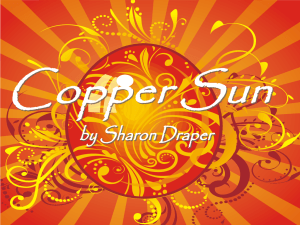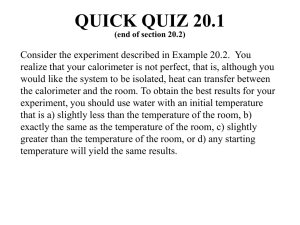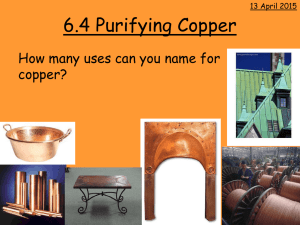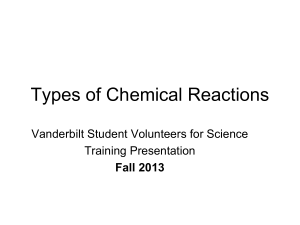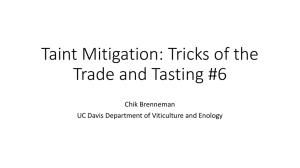June 2010 Regents Exam Part C Questions
advertisement
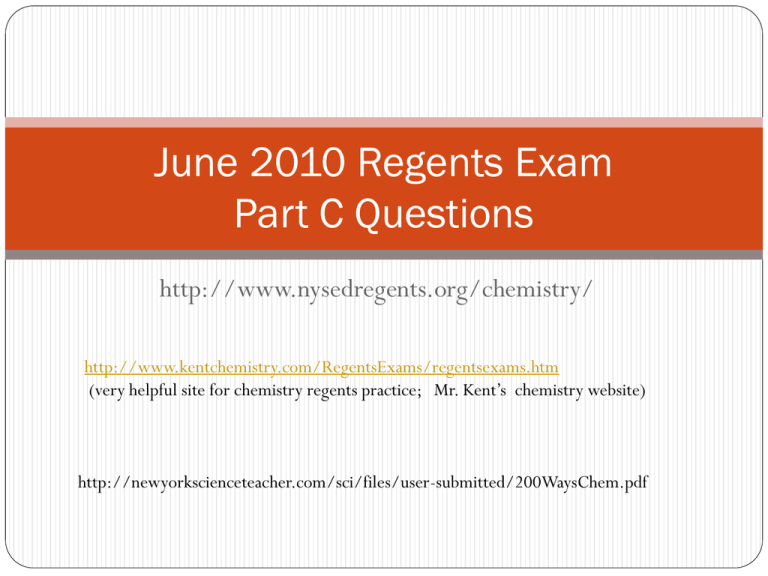
June 2010 Regents Exam Part C Questions http://www.nysedregents.org/chemistry/ http://www.kentchemistry.com/RegentsExams/regentsexams.htm (very helpful site for chemistry regents practice; Mr. Kent’s chemistry website) http://newyorkscienceteacher.com/sci/files/user-submitted/200WaysChem.pdf Base your answers to questions 65 through 68 on the information below. In a laboratory, a student makes a solution by completely dissolving 80.0 grams of KNO3(s) in 100.0 grams of hot water. The resulting solution has a temperature of 60.°C. The room temperature in the laboratory is 22°C. Q 65 Classify, in terms of saturation, the type of solution made by the student. Q 66 Compare the boiling point of the solution at standard pressure to the boiling point of water at standard pressure. Q 67 Describe the direction of heat flow between the solution made by the student and the air in the laboratory. Q 68 Describe a laboratory procedure that can be used to recover the solid solute from the aqueous solution. Sample Individual Solubility CurvePotassium nitrite Saturated Solution: = contains the maximum amount of solute for a given quantity of solvent at a constant temperature & pressure if additional solute is added, it will not dissolve; rather it will precipitate out Unsaturated Solution: = a solution that contains less solute than a saturated solution at a given temperature & pressure if additional solute is added, it will dissolve Supersaturated Solution: = contains more solute than it can theoretically hold at a given temperature crystallization will be initiate if a very small “seed crystal” of solute is added **very unstable** http://www.metacafe.com/watch/4040 10/rapid_crystallization_supersaturated_s olution_demo/ Base your answers to questions 65 through 68 on the information below. In a laboratory, a student makes a solution by completely dissolving 80.0 grams of KNO3(s) in 100.0 grams of hot water. The resulting solution has a temperature of 60.°C. The room temperature in the laboratory is 22°C. 65 Classify, in terms of saturation, the type of solution made by the student. Answer: - the solution is unsaturated. Note that all of the KNO3 dissolved. You will need to use the Solubility Curves Table (Table G) to determine if the solution is unsaturated, saturated, or supersaturated. According to Table G, about 110 grams of KNO3 should dissolve in 100 g of H2O at 60 oC. The student’s solution is therefore unsaturated. Base your answers to questions 65 through 68 on the information below. In a laboratory, a student makes a solution by completely dissolving 80.0 grams of KNO3(s) in 100.0 grams of hot water. The resulting solution has a temperature of 60.°C. The room temperature in the laboratory is 22°C. • 66 Compare the boiling point of the solution at standard pressure to the boiling point of water at standard pressure. • Ans: The Boiling point of the solution is higher than the boiling point of water This Q relates to colligative properties of solutions. Aqueous solutions will always have higher boiling points (and lower freezing points and lower vapor pressures) than pure water. • 67 Describe the direction of heat flow between the solution made by the student and the air in the laboratory. Heat flows from the warmer object (the solution 60 oC ) to the cooler air (22 oC) 68 Describe a laboratory procedure that can be used to recover the solid solute from the aqueous solution. [1] Possible Answers: See next slide •Q 68 Describe a laboratory procedure that can be used to recover the solid solute from the aqueous solution. [1] Possible Answers Include Heating the KNO3 solution removes the H2O (l) from the aqueous KNO3 solution leaving KNO3 (s) behind. Other ways of removing water include” : (1) Just allowing the water to evaporate at room temperature (2) Removing water by distillation since Water and KNO3 will have very different boiling points Question 69-71 involves a kinetic experiment that we studied both in lab and as a virtual experiment At room temperature, a reaction occurs when KIO3(aq) is mixed with NaHSO3(aq) that contains a small amount of starch. The colorless reaction mixture turns dark blue after a period of time that depends on the concentration of the reactants. In a laboratory, 12 drops of a 0.02 M NaHSO3(aq) solution containing starch were placed in each of six test tubes. A different number of drops of 0.02 M KIO3(aq) and enough water to maintain a constant volume were added to each test tube and the time for the dark-blue color to appear was measured. The data were recorded in the table below. Question 69-71 involves a kinetic experiment that we studied both in lab and as a virtual experiment At room temperature, a reaction occurs when KIO3(aq) is mixed with NaHSO3(aq) that contains a small amount of starch. The colorless reaction mixture turns dark blue after a period of time that depends on the concentration of the reactants. In a laboratory, 12 drops of a 0.02 M NaHSO3(aq) solution containing starch were placed in each of six test tubes. A different number of drops of 0.02 M KIO3(aq) and enough water to maintain a constant volume were added to each test tube and the time for the dark-blue color to appear was measured. The data were recorded in the table below. Question 69-71 involves a kinetic experiment that we studied both in lab and as a virtual experiment On the grid in your answer booklet: • Mark an appropriate scale on the axis labeled “Time (s).” [1] • Plot the data from the data table. Circle and connect the points. [1] On the grid in your answer booklet: • Mark an appropriate scale on the axis labeled “Time (s).” [1] • Plot the data from the data table. Circle and connect the points. [1] 70 State how increasing the number of drops of 0.02 M KIO3(aq) used in the reaction affects the rate of reaction. [1] As the number of drops of 0.02 M KIO3 increased, the reaction time became shorter and the reaction rate became faster. 71 Identify one factor, other than the concentration of the reactants, that would affect the rate of this reaction. [1] Possible Answers include - Using a catalyst - Increasing the temperature The Solvay process is a multistep industrial process used to produce washing soda, Na2CO3(s). In the last step of the Solvay process, NaHCO3(s) is heated to 300°C, producing washing soda, water, and carbon dioxide. This reaction is represented by the balanced equation below. 2 NaHCO3 (s) + heat Na2CO3 (s) + H2O(g) + CO2 (g) Q 72 Write the IUPAC name for washing soda. (Hint Use table E) Answer: Q 73 Identify the type of chemical reaction represented by the equation. Answer: The Solvay process is a multistep industrial process used to produce washing soda, Na2CO3(s). In the last step of the Solvay process, NaHCO3(s) is heated to 300°C, producing washing soda, water, and carbon dioxide. This reaction is represented by the balanced equation below. 2 NaHCO3 (s) + heat Na2CO3 (s) + H2O(g) + CO2 (g) Q 72 Write the IUPAC name for washing soda. (Hint Use table E) Answer: Sodium carbonate Q 73 Identify the type of chemical reaction represented by the equation. Answer: Decomposition The Solvay process is a multistep industrial process used to produce washing soda, Na2CO3(s). In the last step of the Solvay process, NaHCO3(s) is heated to 300°C, producing washing soda, water, and carbon dioxide. This reaction is represented by the balanced equation below. 2 NaHCO3(s) + heat Na2CO3(s) + H2O(g) + CO2(g) Q 74 State evidence that indicates the entropy of the products is greater than the entropy of the reactant. Answer: The reactant is a solid but the products are two gases and a solid. Gases have greater entropy than solids. The Solvay process is a multistep industrial process used to produce washing soda, Na2CO3(s). In the last step of the Solvay process, NaHCO3(s) is heated to 300°C, producing washing soda, water, and carbon dioxide. This reaction is represented by the balanced equation below. 2 NaHCO3(s) + heat Na2CO3(s) + H2O(g) + CO2(g) Q 75 Determine the total mass of washing soda produced if 3360. kilograms of NaHCO3 reacts completely to produce 360. kilograms of H2O and 880. kilograms of CO2. (Hint: Conservation of mass question; Item 47 of “200 Ways…”) The Solvay process is a multistep industrial process used to produce washing soda, Na2CO3(s). In the last step of the Solvay process, NaHCO3(s) is heated to 300°C, producing washing soda, water, and carbon dioxide. This reaction is represented by the balanced equation below. 2 NaHCO3(s) + heat Na2CO3(s) + H2O(g) + CO2(g) 75 Determine the total mass of washing soda produced if 3360. kilograms of NaHCO3 reacts completely to produce 360. kilograms of H2O and 880. kilograms of CO2. Answer : 3360 kg NaHCO3 = x kg Na2CO3 + 360 kg H2O + 880 kg CO2 X= In liquid water, an equilibrium exists between H2O(ℓ) molecules, H+(aq) ions, and OH−(aq) ions. A person experiencing acid indigestion after drinking tomato juice can ingest milk of magnesia to reduce the acidity of the stomach contents. Tomato juice has a pH value of 4. Milk of magnesia, a mixture of magnesium hydroxide and water, has a pH value of 10. 76 Complete the equation in your answer booklet for the equilibrium that exists in liquid water. [1] Answer Booklet : _________(l) ______ (aq) + _______ (aq) In liquid water, an equilibrium exists between H2O(ℓ) molecules, H+(aq) ions, and OH−(aq) ions. A person experiencing acid indigestion after drinking tomato juice can ingest milk of magnesia to reduce the acidity of the stomach contents. Tomato juice has a pH value of 4. Milk of magnesia, a mixture of magnesium hydroxide and water, has a pH value of 10. 76 Complete the equation in your answer booklet for the equilibrium that exists in liquid water. H2O(l) H+ (aq) + OH - (aq) or 2 H2O(l) H3O+ (aq) + OH - (aq) In liquid water, an equilibrium exists between H2O(ℓ) molecules, H+(aq) ions, and OH−(aq) ions. A person experiencing acid indigestion after drinking tomato juice can ingest milk of magnesia to reduce the acidity of the stomach contents. Tomato juice has a pH value of 4. Milk of magnesia, a mixture of magnesium hydroxide and water, has a pH value of 10. • Q 77 Compare the hydrogen ion concentration in tomato juice to the hydrogen ion concentration in milk of magnesia. In liquid water, an equilibrium exists between H2O(ℓ) molecules, H+(aq) ions, and OH−(aq) ions. A person experiencing acid indigestion after drinking tomato juice can ingest milk of magnesia to reduce the acidity of the stomach contents. Tomato juice has a pH value of 4. Milk of magnesia, a mixture of magnesium hydroxide and water, has a pH value of 10. • Q 77 Compare the hydrogen ion concentration in tomato juice to the hydrogen ion concentration in milk of magnesia. • Answer: - the Hydrogen ion concentration in tomato juice is greater (The Hydrogen ion concentration is 106 times higher in tomato juice) In liquid water, an equilibrium exists between H2O(ℓ) molecules, H+(aq) ions, and OH−(aq) ions. A person experiencing acid indigestion after drinking tomato juice can ingest milk of magnesia to reduce the acidity of the stomach contents. Tomato juice has a pH value of 4. Milk of magnesia, a mixture of magnesium hydroxide and water, has a pH value of 10. 79 What is the color of thymol blue indicator when placed in a sample of milk of magnesia? (Hint: Use table M) In liquid water, an equilibrium exists between H2O(ℓ) molecules, H+(aq) ions, and OH−(aq) ions. A person experiencing acid indigestion after drinking tomato juice can ingest milk of magnesia to reduce the acidity of the stomach contents. Tomato juice has a pH value of 4. Milk of magnesia, a mixture of magnesium hydroxide and water, has a pH value of 10. • Q 79 What is the color of thymol blue indicator when placed in a sample of milk of magnesia? Answer: Blue Questions 80-83 involve the metal Copper , Cu (s) , and…….. some Copper compounds …. Two sources of copper are cuprite, which has the IUPAC name copper(I) oxide, and malachite, which has the formula Cu2CO3(OH)2. Copper is used in home wiring and electric motors because it has good electrical conductivity. Other uses of copper not related to its electrical conductivity include coins, plumbing, roofing, and cooking pans. Aluminum is also used for cooking pans. At room temperature, the electrical conductivity of a copper wire is 1.6 times greater than an aluminum wire with the same length and cross-sectional area. At room temperature, the heat conductivity of copper is 1.8 times greater than the heat conductivity of aluminum. At STP, the density of copper is 3.3 times greater than the density of aluminum. Q 80 Write the chemical formula of cuprite. Two sources of copper are cuprite, which has the IUPAC name copper(I) oxide, and malachite, which has the formula Cu2CO3(OH)2. Copper is used in home wiring and electric motors because it has good electrical conductivity. Other uses of copper not related to its electrical conductivity include coins, plumbing, roofing, and cooking pans. Aluminum is also used for cooking pans. At room temperature, the electrical conductivity of a copper wire is 1.6 times greater than an aluminum wire with the same length and cross-sectional area. At room temperature, the heat conductivity of copper is 1.8 times greater than the heat conductivity of aluminum. At STP, the density of copper is 3.3 times greater than the density of aluminum. 81 Determine the oxidation number of oxygen in the carbonate ion found in malachite. (Hint Use Table E and Periodic Table) Answer: Two sources of copper are cuprite, which has the IUPAC name copper(I) oxide, and malachite, which has the formula Cu2CO3(OH)2. Copper is used in home wiring and electric motors because it has good electrical conductivity. Other uses of copper not related to its electrical conductivity include coins, plumbing, roofing, and cooking pans. Aluminum is also used for cooking pans. At room temperature, the electrical conductivity of a copper wire is 1.6 times greater than an aluminum wire with the same length and cross-sectional area. At room temperature, the heat conductivity of copper is 1.8 times greater than the heat conductivity of aluminum. At STP, the density of copper is 3.3 times greater than the density of aluminum. 82 Identify one physical property of copper that makes it a good choice for uses that are not related to electrical conductivity. Answer: Copper is a good heat conductor other possible answers for physical properties? copper is maleable; copper has a high metal point) Two sources of copper are cuprite, which has the IUPAC name copper(I) oxide, and malachite, which has the formula Cu2CO3(OH)2. Copper is used in home wiring and electric motors because it has good electrical conductivity. Other uses of copper not related to its electrical conductivity include coins, plumbing, roofing, and cooking pans. Aluminum is also used for cooking pans. At room temperature, the electrical conductivity of a copper wire is 1.6 times greater than an aluminum wire with the same length and cross-sectional area. At room temperature, the heat conductivity of copper is 1.8 times greater than the heat conductivity of aluminum. At STP, the density of copper is 3.3 times greater than the density of aluminum. 83 Identify one physical property of aluminum that could make it a better choice than copper for a cooking pan. Answer: Aluminum is not as dense as copper

